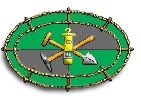 Historical Background
Historical Background
The banks of the River Severn near to the Freebridge,
between Ironbridge and Jackfield are both truly on historic mining ground.
The 17th Century mines beneath the Broseley bank (described in SCMC
Annual Journal No.3 1995) are repeated on the Madeley side.
Sir Basil Brooke (1576-1646) of Madeley Court was Lord of the Manor of Madeley (1598-1646), his family having purchased the rights at the time of the dissolution of the monasteries. (Brooke's statue is on the outside window ledge at Madeley Parish Church and the iron lintel over the furnace hole at Coalbrookdale Museum site bears his initials and the date 1645).
His mines beneath the Madeley (or northern) bank were said to be the most productive in Shropshire producing over 30,000 tons of coal per year. He is also credited by some as being the developer of the 'Shropshire' longwall method of working - now used in mines around the world.
Understandably these mines attracted the attentions of the Parliamentarians for not only were they rich but Brooke was a Royalist and a Catholic. In 1645 the mines fell to the Parliamentarians who let them to Richard Foley and then to Edward Cludde. By the time Cludde took them over they had fallen into decay and he set about restoring them to their former greatness. By 1650 attempts were being made to sort out their values and ownership and interesting information is provided by the evidence given about the mines and miners.
Brooke's Insetts
Brooke had worked at least four insetts (or adits) using master "grubbers" (grubbe= miner in German), normally two partners at each insett with their own workmen:
- Oliver Crompton was a grubber, he had worked 40 years in the pits, 20 years in his present one, which was 1000 yards long. It had a main road, all supported by timber. This had cost £50 in workmanship and £250 in timber, with additional cost for drainage work. Previously the short term tenants had allowed the mine to deteriorate.
- Robert Lewis, master grubber, said his pit had a pump which could force water 400 yards.
- E.Lewis worked in a pit known as the 3rd Insett, it was 700 yards long and £450 was spent in workmen's wages in 1649 (at which time a miner would get £15-17 per year, so probably he employed 30-40 workers).
- J.Davies worked the 4th Insett, it had a pump to force water and was 400 yards long.
There was a mention also of other insetts - it would be interesting to know what type of pump was available at the time to force water 400 yards!
Madeley Bank Mines
By 1700 the whole of the Madeley bank of the River at this point was
pock-marked with adits - laterally along the seam outcrops and vertically
in the different seams of ironstone, coal and clay. VIP's came to view
them:
- Francis Brokesby in 1711 said here "there were considerable coal mines into which they deemed not to descend as in other places into pits, but go in at the side of the hill into which there are long passages both straight forward and from there on each side" (the longwall system ?). The coal was "thrust by men" out of "long underground passages even to the boats which lie in the Severn" (from Leland, 1768 Itinary VI).
- In 1773 John Fletcher, the saintly vicar of Madeley, described a trip into a "sloping pit" (a drift) which was "supposed to be near a mile under the ground" (Wesleys Life of Fletcher, 1786).
By the 1790's these adits were connected to the surface by deep shafts higher up the hill.
- Plumptre describes a trip in about 1790 through "Bedlam" Mine, which might have been the Crawstone or (later) Styches Pit, since the distances given are similar (357ft. down to the Little Flint Coal in 1909).
- He was let down 300ft. using a windlass, "went along a level some way by iron-roads (tramway tunnels), very dirty and stooping, got into a carriage and went to end".
- In all 1200ft. of level of which he rode 480ft. He was then given a choice, to walk out through the adit - or to go up the shaft again. He chose the later!
From the 1750's control of the mines had passed to the Madeley Wood Company partnership. This was formed in 1756, the same year that Richard Reynolds arrived in the area, and consisted of twelve local notables including a Brooke and several master colliers. The partnership built the Bedlam Furnaces in 1757 and acquired the mineral rights for coal and ironstone in the Madeley Parish. In 1776 Bedlam was purchased by Abraham Darby II of the Coalbrookdale Company, but after their split with the Reynolds family Bedlam and its mines passed to the Reynolds and then the Anstices.
By 1844 the Anstices had moved the works from Bedlam towards Blists Hill and Shifnal.
Plans and leases of this particular area for the early 19thC. show the position of some of the shafts with their names, but by 1847, the date of the Tithe Map, only one colliery, a Water Pit and a Clay Mine are shown to be operational on the lower slopes (W.W.Smythe had however painted a productive mine here in the early 1840's). While all adit working seems to have ceased at the time Bedlam closed, some of the tunnels were still in use for bringing coal and clay to the brickworks and river wharfage. (see Plan).
Landslips
Over the last 150 years the Gorge hillside has been subject to landslips
and flow-slides, many properties have become unstable or physically destroyed,
particularly in the 1930's and again more recently.
Even the mine adits have been crushed and lost, and shaft tops have collapsed, with evidence that the shafts themselves have been sheared - their tops being moved nearer the river. Some of the brickwork from the surface structures remains, but probably not in its original position and until recently "beehive" shaft coverings could be found. Amazingly several squatter-type cottages remain in place (one with a distinctive lean caused by movement) and others on the unvegetated ironstone tip above the new road bridge across the River between Ironbridge and Jackfield. One of these has since the late 1700's been the "family" home of the Browns.
No adits or tunnels have been located in the Madeley Bank-Bedlam area, probably because they are all well covered by a thick layer of detritus. Several shafts tops are still identifiable by their earth collars or brickwork, but whether in their original position or not is debatable. The general location of the known named pits is shown on the plan.
The Cluddes
By 1649 the workings on the Madeley or North bank of the River around
Bedlam were in the control of Edwarde Cludde. The Cluddes came
from Cluddley near Wellington and feature in later mining incidents. It
was a Cludde, who with Edward Pemberton raised a force of 1,500, principally
Wellington trades people, against local miners during a riot in 1756.
Ten miners were taken prisoner, two were hanged.
It was another Cludde who gave the order to shoot local miners during the Cinderhill riots of 1821. Two miners were fatally wounded, another executed and seven jailed. Distant relatives of the Cluddes still live in the area - for details see Victoria County History Vol.XI, 1985 index.
References Unless quoted in text:
|
Credits: Report: Ivor Brown Warning
If you visit the area: DO NOT enter any workings or tunnels without proper precautions - people have died in tunnels in the Gorge through bad air, so BEWARE. |
